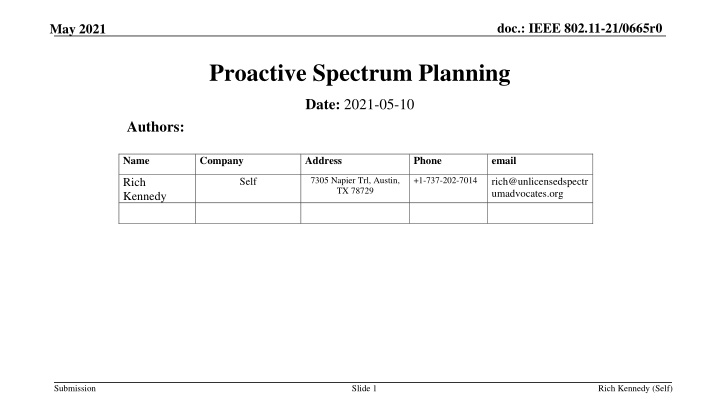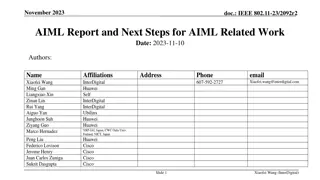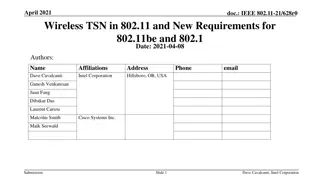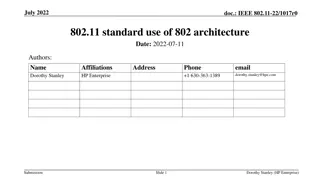IEEE 802 Spectrum Planning: Proactive Approach for Improved Spectrum Management
Exploring the need for proactive spectrum planning in IEEE 802 to better manage the complex process of meeting spectrum needs efficiently and effectively. Delving into the challenges of spectrum allocation, sharing, and optimization to ensure that standards have the RF spectrum necessary for their ratification.
Uploaded on Oct 07, 2024 | 14 Views
Download Presentation

Please find below an Image/Link to download the presentation.
The content on the website is provided AS IS for your information and personal use only. It may not be sold, licensed, or shared on other websites without obtaining consent from the author.If you encounter any issues during the download, it is possible that the publisher has removed the file from their server.
You are allowed to download the files provided on this website for personal or commercial use, subject to the condition that they are used lawfully. All files are the property of their respective owners.
The content on the website is provided AS IS for your information and personal use only. It may not be sold, licensed, or shared on other websites without obtaining consent from the author.
E N D
Presentation Transcript
doc.: IEEE 802.11-21/0665r0 May 2021 Proactive Spectrum Planning Date: 2021-05-10 Authors: Name Company Address Phone email 7305 Napier Trl, Austin, TX 78729 +1-737-202-7014 Self rich@unlicensedspectr umadvocates.org Rich Kennedy Submission Slide 1 Rich Kennedy (Self)
doc.: IEEE 802.11-21/0665r0 May 2021 Abstract Meeting spectrum needs is a complex and an excruciatingly time consuming process. This presentation explores how IEEE 802 could better manage the process by being proactive. Submission Slide 2 Rich Kennedy (Self)
doc.: IEEE 802.11-21/0665r0 May 2021 Problem Statement EXAMPLE: The 6 GHz band was recently added for IEEE 802.11 The process has taken 4+ years and tremendous resources (so far) It is not (yet) globally harmonized 5925 MHz to 7125 MHz in some regulatory domains, limited to 5925 MHz to 6425 MHz in others Very Low Power, Indoor only, geolocation restrictions, etc. Technology is ready, but rollout will be slow and torturous Many regulatory domains not available Different specifications based on locale Portability hampered by geolocation requirements We got a lot less than we hoped for Can we do a better job to ensure the standards we create have the RF spectrum they need at the time of their ratification? Submission Slide 3 Rich Kennedy (Self)
doc.: IEEE 802.11-21/0665r0 May 2021 RF Spectrum Complexities Radio Frequency spectrum is poorly allocated Developed over the course of decades Frequency allocations were driven by technology limitations; not optimized for applications With no incentive to move, licensees continue in sub-optimal frequency bands Lack of accurate spectrum inventory leaves some spectrum unused or underused Expired licenses, obsolete applications, etc. Opportunities for spectrum sharing are limited If we could start over Short range devices best in highest frequency bands; long range in mid and low bands All allocations should have sharing provisions but we can t Submission Slide 4 Rich Kennedy (Self)
doc.: IEEE 802.11-21/0665r0 May 2021 The Art of Spectrum Complexity Submission Slide 5 Rich Kennedy (Self)
doc.: IEEE 802.11-21/0665r0 May 2021 Optimizing From Where We Are Today Comprehensive spectrum inventory is necessary We can only fix what we know for certain is broken Regulators are required to be technology neutral Licensed and licensed-exempt (unlicensed) must have equal opportunities IEEE 802.11/15 have both proven that sharing is viable and valuable Biases hamper spectrum optimization New or replacement allocations should be optimized Spectrum bands allocations should be selected based on application requirements Provision for sharing should be taken into account in any new allocations Submission Slide 6 Rich Kennedy (Self)
doc.: IEEE 802.11-21/0665r0 May 2021 What Can IEEE 802 Do? Proactivities Survey existing spectrum bands (low, mid, high) for potential sharing candidates Applications should drive band selections Set up a task force for spectrum discussions (802.18?) With the cellular industry With regulators Work with the cellular industry on sharing opportunities Can we avoid the competition that slows the process? Extol the successes of license-exempt/unlicensed wireless technologies and their value as part of cellular networks Build a coalition of industry leaders To lobby for spectrum inventory globally To work on changing the regulations Slide 7 Submission Rich Kennedy (Self)
doc.: IEEE 802.11-21/0665r0 May 2021 Next Steps Radio Regulatory TAG engagement Fine tune this proposal Begin surveying existing allocations for sharing opportunities generally Focus on recent sharing successes, e.g. 6 GHz Closely monitor both 802.11 and 802.15 WNG groups for potential new spectrum requirements Submission Slide 8 Rich Kennedy (Self)
doc.: IEEE 802.11-21/0665r0 References US FCC Table of Frequencies https://transition.fcc.gov/oet/spectrum/table/fcctable.docx European Table of Frequency Allocations https://docdb.cept.org/download/2ca5fcbd-4090/attachments/2013_ERCRep025.pdf ECO Frequency Information System (cept.org) Submission Slide 9 Rich Kennedy (Self)























